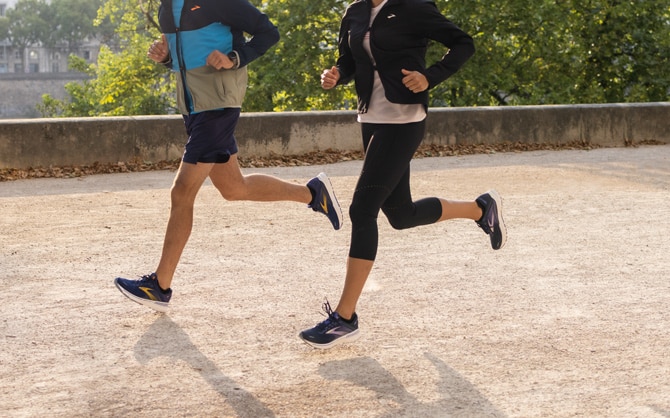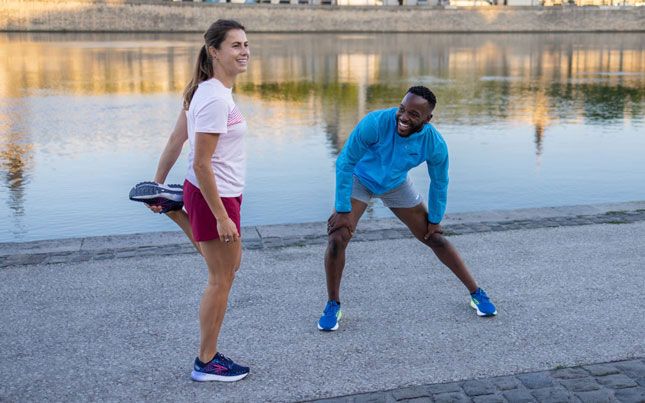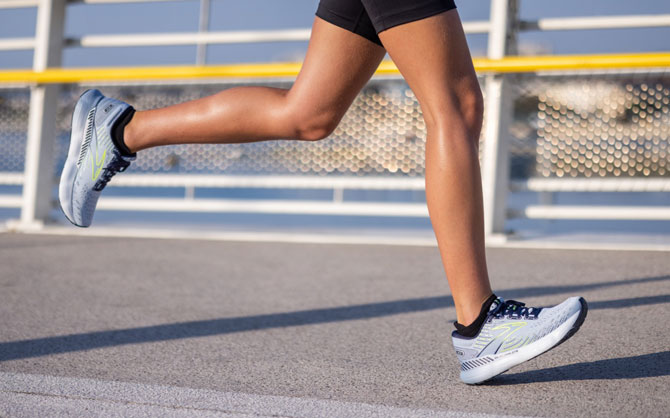Heel pain after running

Do you get heel pain after running? You’re not alone. It’s one of the most common running complaints – but what causes it? And, importantly, how can you recover from pain in your heels after running? Let’s dive right in.
What is heel pain (plantar fasciitis) after running?
Plantar fasciitis is the most common cause of heel pain for runners. But what exactly is it?
The plantar fascia is a thick band of ligament that runs along the bottom of the foot, connecting your heel to the front of your foot. It supports the arch of your foot while you walk and helps to absorb the impact of your feet hitting the ground. Sometimes, the plantar fascia can become irritated, which leads to a sore heel and stiffness when you walk or run. There is some debate among doctors as to what causes this pain. It was long thought that plantar fasciitis is caused by inflammation of the plantar fascia, but it’s also been found to be caused by a thickening of the fascia ligament, and a weakening of the collagen fibres surrounding the fascia.
Plantar fasciitis can be very painful. The main symptom is a sharp, stabbing pain, or deep ache in the heel, or along the arch of the foot. Some people might also feel a burning sensation across the bottom of their foot, extending outwards from the heel. Other symptoms include:
- Pain that’s much worse when you first start walking in the morning after waking up, or if you’ve been sitting or lying down for some time
- Finding it difficult to raise your toes off the floor
- Pain that feels better when you’re walking or running, but comes back after resting
- Difficulty climbing stairs

What causes heel pain when running or after running?
We’ve already mentioned that plantar fasciitis can be caused by inflammation of the plantar fascia, or by a thickening of the ligament. But what causes this to happen?
One of the most common reasons for plantar fasciitis when running is doing too much too soon, or overtraining. If you’re not used to running long distances, or on several days a week, and suddenly ramp up the mileage, then you may suffer from an injury like plantar fasciitis. You may also develop plantar fasciitis if you fail to stretch your calf muscles before and after you run or develop tight calves or Achilles tendons through running workouts like hill repeats and speed sessions. If your calves are extremely tight, they can pull on the plantar fascia ligament, resulting in heel pain.
Some people suffer from plantar fasciitis because of the gear they’re wearing. Old, worn-out shoes don’t provide enough arch support, which could result in injury – especially for people who already have biomechanical issues, like flat feet or high arches. Similarly, if you wear high heels all day, and then switch into running shoes without adequate support, you may end up with heel pain.
Some other things that increase the risk of developing plantar fasciitis include:
- Being overweight or obese, as the weight bared by the plantar fascia is increased
- Ageing, as the enthesis (the insertion of the ligament into the bone) becomes more brittle with age, increasing the risk of injury
- Limited ankle dorsiflexion
- Limited mobility in the extension of the big toe
- Standing for long periods of time
Other causes of heel pain after running
Although plantar fasciitis is the main cause of heel in your plain after running, it’s not the case for everyone. Other causes include:
- Achilles tendonitis, an inflammation of the Achilles tendon (the band of tissue that connects the muscles in the lower leg to your heel bone), that can cause pain, swelling and swelling in the heel.
- Tibialis posterior tendinopathy: Like Achilles tendonitis, the posterior tibial tendon (which attaches the calf muscle to the bones on the inside of the foot) can become inflamed.
- Stress fracture: There are several different types of stress fractures that can cause heel pain after running similar to plantar fasciitis, including a calcaneal stress fracture (when there are several small breaks in your heel bone, often brought on by repetitive activities such as running), and navicular stress fractures (the bone at the top of the middle part of your foot, which can be put under a lot of pressure when running or walking a lot).
- Wearing running shoes that aren’t the right fit for your pronation type can place increased pressure on the plantar fascia and heel pain.

How to prevent heel pain after running
If you have plantar fasciitis from running, there’s one question you’ll be desperate to know the answer to: how can you make the pain go away? Prevention is better than cure, so here are our top tips for preventing sore heels in the first place.
Rest
As much as runners hate to hear it, rest really is one of the best cures for plantar fasciitis – for mild cases, at least. If you have heel pain after running and you don’t rest up, you run the risk of making it worse. It’s important to rest when recovering from any injury, and heel pain is no different.
Taking a break from running will help to reduce the inflammation or thickening of your fascia, which will in turn reduce the pain you feel. Once your symptoms have cleared up, you can start running again – but take it easy, as jumping straight back into long distances or lots of speedwork could ignite your injury again. It can be frustrating, but resting could make the difference between a short-term case of plantar fasciitis and a long-term injury.
Reduce your load
If you keep getting recurring bouts of heel pain after running, it’s wise to reduce your running load. Try running on softer surfaces like grass and trails to reduce the amount of impact on your heels and ligaments and consider replacing one run each week with a cross-training session instead such as swimming or cycling.
Plantar fascia stretch
Sit with both legs outstretched, then place a towel around the ball of the affected foot. Keep your heel in contact with the ground, then pull the towel towards you until you feel a stretch in your plantar fascia along the bottom of your foot, and the back of your calf. Hold the stretch for 20 seconds and repeat a few times.
Toe stretch
Sit in a chair with the affected foot crossed over the knee of your other leg. Hold your toes with one of your hands, and gently pull them towards you until you feel a stretch in the arch of your foot. Hold for around ten seconds and try massaging the arch of your foot with your other hand.
Calf wall stretch
It’s a good idea to stretch your calves as well as your plantar fascia, and this stretch targets both. Place your hands on a wall, then place the toes of the affected foot against the wall, with your foot at a 45-degree angle. Keeping the heel of the affected foot against the ground, bend your front knee while moving your body closer to the wall until you feel a stretch both in the back of your calf and the bottom of your foot. Hold the stretch for 20 seconds and repeat several times.
Gastrocnemius and soleus muscle stretches
These are the two main muscles in your calf and stretching them both will help to improve the symptoms of plantar fasciitis, as well as making it less likely to return in the future. To stretch your gastrocnemius, stand facing a wall, and place both hands on the wall at eye level. Step back with one leg, keeping your heel on the floor and turning your foot inwards slightly. Keep the back leg straight and start to bend the knee of your front leg, and slowly leaning forward from your hips so your chest moves in the direction of the wall. Do this until you feel a stretch in the back of your calf, then hold for 20 seconds. Repeat several times, then swap legs. To stretch your soleus, repeat the gastrocnemius stretch, taking the same stance. This time, when you bend your front knee, also bend the knee of your back leg. You should feel a stretch deeper in your calf muscle. Again, hold this for 20 seconds, repeat a few times, then swap legs.
Calf raises
This exercise should help you to strengthen the muscles in your calves and your feet. Stand in front of a wall, and place your hands on the wall lightly, for balance. Come onto your tip toes, lifting both heels off the ground. Then, when you’ve raised your heels as far as is comfortable for you, begin to slowly lower then back down to the ground. Do as many as you feel comfortable with to begin with, but the aim should be around three sets of 10-15 repetitions.
Change your shoes
Your running shoes can make a big difference if you get sore heels from running – but it also makes a difference what shoes you wear when you’re not running. Walking around your house barefoot or wearing shoes with minimal arch support when out and about can make your condition worse.
The most important things in a pair of running shoes for plantar fasciitis are arch support and cushioning for your heels. Something like Brooks’ Adrenaline GTS is the perfect choice for runners struggling with heel pain after running, as lightweight DNA LOFT v2 cushioning delivers softness underfoot, while our innovative GuideRails® support technology helps to align the body in its natural movement path, keeping excess movement in check.
Wear proper running socks
Running socks tend to have padding in the heels, which can help to offer some comfort and an extra layer of protection while you have issues with your heels. You can even get socks that are designed specifically for plantar fasciitis, with compression zones to support your heel and Achilles, while giving you the range of motion you need to run comfortably.
Wear night splints
Your physiotherapist or doctor may recommend trying night splints. Plantar fasciitis is often worse in the morning as the plantar fascia gets shorter overnight and doesn’t like suddenly being stretched in the morning. Night splints keep your plantar fascia stretched out overnight, so it’s less painful when you try to walk on your rested feet.
Taping
If you have mild plantar fasciitis, and want or need to keep running, you could try taping your feet with kinesiology tape. This supports your ligaments, helping to stabilize your plantar fascia and supporting the arch of your foot.

Can you run with heel pain and plantar fasciitis?
Another key question you’re probably asking yourself is: can I run with sore heels after running? You’re not going to like the answer, which is: it depends. If the pain is relatively mild, then you’re probably okay to keep running – but you should keep the distances short and avoid any hard efforts while you’re suffering with the symptoms of plantar fasciitis or any other type of heel pain. However, it’s important to keep an eye on your pain levels over the next 24 hours after your run. If it gets worse, then it’s a sign that you should take some rest rather than trying to push through the pain. If your heel hurts after running, it’s better to take some rest – and to seek advice from a medical professional.
When should you visit a doctor for sore heels after running?
As runners, we can all be guilty of ignoring a niggling pain and just running through it. Sometimes, that’s the right thing to do – and sometimes it’s not. So, when should you see a healthcare professional because of your heel pain after running?
If the pain persists for more than a week or two, it’s a good idea to see a doctor or physiotherapist. They’ll ask you about your symptoms and when you experience heel pain after a run, as well as finding out what treatments you’ve already tried to relieve the pain. They may prescribe rest, but they might also suggest other types of treatment such as specialist orthotics, cortisone injections, anti-inflammatory medicine, shock-wave therapy or even surgery for severe cases. Surgery is a last resort and will usually only be suggested if no other treatments have worked for you.
Reducing heel pain when running
Heel pain after running can be real… well, pain. At best, it can cause discomfort on the run, and at worst, it can be completely debilitating. If you suspect you have plantar fasciitis, it’s best to consult with a doctor or physiotherapist, who can diagnose what type of heel pain you’re experiencing, as well as recommending the best course of treatment for you. If you have mild heel pain, you may be able to keep running – but in most instances, the best treatment is rest and stretching. Stay patient, and you’ll soon be out running happy again!
